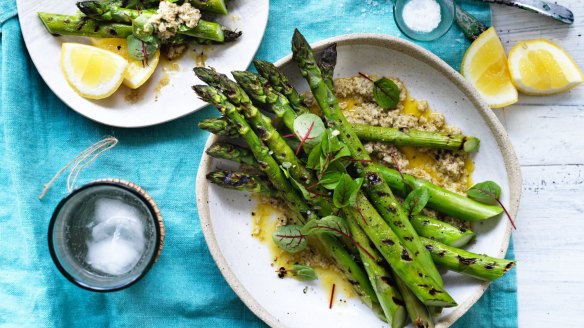Which is better: fat or skinny asparagus?

Thick or thin asparagus, which is better? E. Tobin
You may have noticed that asparagus comes in different hues of green; some have a tinge of purple. Australian asparagus farmers grow different varieties to span the growing season, which starts in September and peters out in March. Some varieties are thick, some are thin, and within varieties some spears grow thicker or thinner. There is a heirloom variety that grows wild along the Murray River banks. I remember walking with Mildura chef (and now local politician) Stefano de Pieri at this time of the year about a decade ago picking matchstick-thin stems of asparagus. As we walked, Stefano retold the story of a sort of Antipodean Johnny Appleseed – Asparagus Annie, if you will – who planted asparagus along southern Australian waterways. Fine-textured, dense and almost bitter, they were so full-flavoured they were like the essence of asparagus. Stefano's dish of choice was a simple frittata of eggs, parmesan, a little cream, salt and pepper, the eggs still slightly wet, which he started by slowly softening the asparagus in plenty of extra virgin olive oil. What a luxurious little dish. Thin spears are more intense in flavour and are best steamed or blanched. Blanch thin asparagus and line a vegetable terrine or simmer in chicken stock, puree, chill, season and serve as a cold summer soup with a little chevre. Thicker stems have more moisture and thicker skins and are great grilled or in stir-fries. Render some pancetta in a pan and slowly cook thick asparagus in the fat, dressing with pepper and pecorino. I remove the rubber band around the bunch to stop the spears from bruising, wrap them in a clean cloth and store them in the fridge. I break the woody ends from the asparagus by hand. Asparagus loves salt, extra virgin olive oil, butter, bacon, parmesan, pepper, lemon juice, sherry vinegar, eggs, and jamon.
I use fresh mozzarella for my pizza, but it makes the crust wet. L. Simmons
I used to visit a small cheesemaker in Melbourne's inner north to watch an Italian woman hand-stretch mozzarella. Chunky white curds, made over the previous days, were cut and poured into a large stainless steel bowl. Then steaming hot water was poured over the curds, releasing billows of vapour into the chilled air, the perfume of fresh milk following the white clouds. With unbroken concentration the woman, her dark hair pulled back tightly under a net, worked the hot mix without flinching, punching in her hands, presumably made from asbestos, and clenching them onto the curd as it melted into a shiny mass. She pulled up sheets of the melted cheese. "Pasta filata," she would say, referring to the sheets of stretched curd. Then, in the blink of an eye, she formed it into a small smooth-skinned ball she called fiore di latte, as it was made with cow's milk (authentic mozzarella is made with buffalo milk). Whether made from cow's or buffalo milk, you will find quite a lot of liquid in fresh mozzarella. When cut or heated, this fluid will leak from the cheese into the crust and make your pizza soggy. So, several hours before baking your pizza, slice the fresh mozzarella, place flat on a clean dishcloth, cover with another and place a baking tray on top. This will dry out the cheese and solve your problem. When choosing a fresh mozzarella, avoid one with a short best-before date, make sure the brine it is sold in looks reasonably clear, and the skin is smooth, white, and bright. (Seasonal variations in feed for the cattle or buffalo can result in a slightly more creamy colour.) Keep it in its liquid in the fridge and treat like other perishable food. If you buy the rubbery industrialised version, which is perfect for stretchy cheese toppings on family meals, and struggle to grate it, try freezing it for 30 minutes beforehand. It will be much firmer and easier to use.
Send your vexing culinary conundrums to brainfood@richardcornish.com.au or tweet to @foodcornish
Appears in these collections
- More:
- Food
- Brain food
